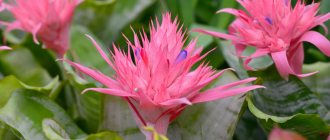European flower growers became acquainted with a gorgeous representative of tropical flora in the second quarter of the century before last.
The Eucharis flower, which arrived from the South American continent, quickly captivated the hearts of true connoisseurs of beauty, and the number of its devoted admirers increases year by year.
This is entirely facilitated by the decorative effect, delicate aroma and undemanding nature of the plant in terms of growing conditions. Informative! The greatest distribution of Eucharis species is observed in the humid areas of the Amazon River basin. Because of this circumstance, the plant is romantically called the “Amazon lily.”
Description
Eucharis belongs to the Amaryllidaceae family. The plant belongs to the category of bulbous flowers, since it has small bulbs completely covered with golden scales. In adult Eucharis, it is rare to see bulbs whose diameter exceeds 60 mm.
The plant can also be found in the wild . Typically, wild varieties have only 2-4 leaves, while indoor varieties have a significantly larger number of leaf blades. The reason for this phenomenon is the fact that when planting eucharis in a pot at home, several bulbs are used at once.
This planting helps to grow a more lush and spectacular plant, since it has more leaves. And bulbs bloom more readily in a pot if there are several of these plant elements in it at once. Eucharis flowers are showy, white with a golden crown. Their aroma is subtle, barely perceptible.
The leaf plates of Eucharis are quite large: they are oval in shape and reach 35-45 cm in length and 15-20 cm in width. The plates become pointed at the ends. The leaves are attached to the bulbs using elongated petioles (each can reach 25-30 cm in length). The surface of the leaf is wrinkled, with a glossy sheen and noticeable longitudinal veins of a dark green color.
Important! Eucharis leaves do not lose their decorative effect for many years, although over time they may fall off, allowing young shoots to take their place.
Botanical description
Eucharis amazonica is a bulbous plant. The spherical bulbs of Eucharis reach a diameter of 6 cm. The leaves are dark green in quantities from 2 to 7 pieces, wide, lanceolate, on long thick petioles, up to 55 cm long, up to 20 cm wide. The texture of the leaves is slightly wrinkled, with protruding longitudinal veins. The fragrant flowers of eucharis, appearing on a peduncle up to 80 cm long in August or September, resemble daffodils - large, white, collected in umbrella-shaped inflorescences of 3-10 pieces, with a crown, the color of which, depending on the species, can be green or yellow. The Eucharis fruit is a three-chambered leathery capsule.
- Krinum: cultivation and care, types and varieties
Home care
Eucharis cannot be called a too demanding plant to care for . But this does not mean that he does not need to pay attention at all. In order for it to delight you with its bright greenery and lush flowering, you need to follow a number of rules when caring for it.
How to care for an Amazon lily?
Standard care for eucharis involves maintaining temperature, watering and lighting conditions.
Temperature
Correctly setting the temperature in the room with the flower is already half the success. Since eucharis is a tropical plant, in summer it will be comfortable at a temperature of +26...+28 degrees. In winter, the thermometer should not fall below +12 degrees. Violation of the temperature regime leads to the fact that the plant begins to grow poorly and get sick .
Spraying
When growing eucharis at home, the air should not be allowed to become too dry. The plant requires high humidity (55% and above).
So be sure to place the container with the flower on a tray with moistened expanded clay, and also use specialized air humidifiers. Spraying is also permissible, but it must be carried out with extreme caution, spraying only the leaf plates with water.
Light mode
In the wild, Eucharis usually grows in the shade of taller plants . So when growing a flower at home, try to provide it with slight shading and diffused light.
Place the container with it on the western or eastern window. If you installed the flowerpot on the south side, be sure to shade the plant on a hot afternoon. And if the flower is on the north side, then you will have to provide it with additional lighting from phytolamps.
Watering
Eucharis loves moisture, but you should not pour liters of water into the substrate . Watering should be done only when the soil in the container is dry by about a third of the total volume. Excessive moisture will lead to rotting of the bulbs and, accordingly, the death of the plant. It is advisable to use bottom watering for eucharis, in which water is poured into a pan and then the excess is drained after 48 hours.
Important! For watering eucharis, it is allowed to use only warm, settled water. Immediately after adding liquid, the tree trunk circle of the plant is mulched with coconut substrate or finely chopped bark.
Fertilizer
In order for eucharis to delight you with abundant flowering for many years, it must be provided with fertilizing. At the height of flowering, you need to add a liquid mineral mixture, diluted with water twice, once every 2 weeks.
Some gardeners advise alternating mineral complexes and organic matter, but you should not get carried away with this when growing at home, since organic fertilizers have a detrimental effect on the condition of the bulbs.
Fertilizers should be applied immediately after evening watering . After this, the plant needs to be shaded for 48 hours. As soon as flowering ends, fertilizing is excluded from the care routine.
Priming
These plants prefer nutritious soil mixtures that are well-drained. You can prepare a suitable substrate at home: mix peat, turf soil, perlite in a 1:1:1 ratio, and then add two parts of leaf soil to them. If you don’t want to bother with the substrate yourself, you can purchase ready-made universal soil in the store.
Important! To any substrate you need to add coal powder, brick chips and vermiculite. This will help improve the quality of the soil mixture, making it looser.
Care
The Amazon lily can live in your home for many years. The way to successfully grow this plant is to keep it away from bright light and direct sunlight. The ideal location of the flower is the eastern or western side, where the midday sun will not touch its leaves. Intense but diffused light is what your green pet will surely like.
In the summer, eucharis will feel great on a glassed-in veranda. But if it is too open to direct sunlight, the plant needs to be shaded with something. Keep this in mind if you are going to place the flower on the balcony.
Air temperature
Eucharis is a rather heat-loving plant, it’s not for nothing that its homeland is hot tropical forests . But during different phases of the life cycle, this plant requires different temperature conditions. In any case, try to maintain the temperature in the room where this flower is located at least 15 degrees.
During the growth period, the Amazon lily needs more heat, the optimal temperature is about 18 degrees. The same applies to the winter period.
For good flowering, eucharis needs moderate, stable heat without temperature changes.
Try to provide the plant with uniform heat, do not allow sudden temperature changes with a large amplitude: this leads to crushing of flowers and disruptions in the frequency of flowering.
Temperatures ranging from 7 to 10 degrees for eucharis are defined as damaging. Under such conditions, it begins to shed its leaves, and its bulbs freeze slightly.
Watering and spraying
Eucharis, like all plants of the amaryllis family with bulbous roots, is sensitive to soil moisture. To put it simply, the leaves love water, but the roots are afraid of excess moisture. Therefore, control how moist the soil in the flower pot is, and avoid stagnation of water in every possible way, otherwise the root system will begin to rot .
Don't forget the most common rule: water abundantly, but infrequently. It's better to wait until the soil dries out. If it is wet to 3cm deep, delay watering for a couple of days .
The technique of watering eucharis also has its own characteristics. Never pour water into the center of the flower, where the leaves emerge from the bulb . The correct distribution of water along the walls of the pot will be correct. This way the soil will be optimally saturated with moisture, and the bulb will be protected from waterlogging.
Do not let too much water get on the leaves. to avoid burns
If you have just transplanted Eucharis, water it carefully in small portions. When new leaves begin to emerge, increase watering.
During active growth, keep the soil moist 2-3 times a week. The soil or substrate in a flower pot should always be moderately moist, but without stagnant water.
To encourage flowering, reduce watering by 5-6 weeks as spring approaches. After the buds appear, watering must be resumed to its previous state.
The Amazon lily has very large leaves on which house dust accumulates. As you know, a large amount of dust on plants prevents the access of air and sunlight. Therefore, the leaves must not only be regularly wiped with a damp sponge (only carefully so as not to break them), but also sprayed with water from a spray bottle. This way you will not only “clean” the flower, but also bring the conditions of its maintenance closer to natural ones: in its homeland, in the tropics, eucharis does not know a shortage of rain and humidity.
Top dressing
The need for feeding in eucharis arises only during the period of flowering and active growth . As soon as a bud emerges from the bulb, feed the flower every 10 days with a solution of organic fertilizers - mullein, ash. During active growth, alternately apply mineral and organic fertilizers twice a month. You can purchase them in ready-made form at hardware stores. Special fertilizers for flowering or bulbous plants are excellent.
Eucharis loves organic and mineral fertilizers
After the eucharis fades, feeding should be stopped.
Flowering time
During this period, in addition to feeding, the flower needs proper watering. It is very important to prevent waterlogging of the soil, when the plant bulb devotes so much energy to the flowers and the formation of seed boxes from them. Water the lily with water at room temperature as the soil dries . It is very important to provide holes in the bottom of the pot and mandatory drainage.
During the flowering period, eucharis needs special care.
During flowering, spray with eucharis, but do not allow water to get on the flowers. In addition, drops of moisture should not concentrate on the leaves: this can cause burns. Constantly wipe dust from the leaves.
Do not move the flower pot to another place during flowering.
Rest period
The dormant period begins immediately after the eucharis flowers and lasts from 35 to 50 days. The flower stalks are removed, feeding the plant is stopped, and watering is reduced to a minimum . This time is needed so that the lily does not immediately start throwing out new leaves, but has time to shed the old ones first. And the root system will thus gain strength for new flowering.
If you wish, you can place the pot of eucharis in a cooler room during the dormant period. But do not forget about the temperature regime of at least 15–18 degrees.
This is what eucharis looks like during the resting period
Such manipulations with watering and alternating temperature conditions during periods of growth and dormancy easily lead to the fact that eucharis blooms twice or even three times a year. Typically, the most active growth of bulbs occurs in the middle of winter, and by March the plant forms a full-fledged flower arrow.
As soon as you notice new shoots, resume watering and fertilizing.
Transfer
Eucharis does not tolerate any touching of the bulbs, as well as changes in place of residence . So you shouldn’t replant it too often. Typically, a plant is transplanted in early spring, 3.5-4 years after the last transplant. By this time, new strong bulbs should already have formed in the planting container, and the roots should cover the entire earthen ball.
How to replant a flower:
- Remove the eucharis from the planting container, carefully removing earthen clods from the roots.
- Small baby bulbs can be left on the roots, or they can be planted separately, having previously been separated from the mother plant.
- Pour drainage material into the bottom of the new pot and cover everything with a suitable substrate on top.
- Deepen the bulbs to a depth of 5 cm. If there are no leaves, then the bulb is not completely covered with soil, leaving the growing point on top.
- You need to plant the bulbs every 5 cm from each other, placing 4-7 pieces in one pot at once.
- Shade the plant by watering it with warm, settled water (but do not over-moisten the soil).
Eucharis transplant is shown in the video:
Common types of indoor flowers
The indoor eucharis flower has several types, which differ in size and flowering time.
- Eucharis grandiflora is most often found on window sills. With good care, it is able to bloom three times a year: in late summer, winter and late spring.
- White Eucharis (Eucharis candida) has wider elliptical leaves, pointed at the tips. Their length can reach 40 cm and width - 15 cm. Peduncles with a brownish-green tint appear in early spring.
- Eucharis mastersii is more compact in size: the length of its leaves does not exceed 25 cm. It forms no more than two inflorescences on each arrow.
- Another compact species, Eucharis sanderi, has heart-shaped leaf bases. It blooms between February and April.
- Eucharis subedentata or, as it is sometimes called, callifruria toothless, is distinguished by its abundant flowering - 6-8 inflorescences per arrow. It is easily recognized by its oblong leaves of an unusual “triangular” shape, sitting on long grooved petioles.
How to propagate?
Since eucharis is a bulbous plant, it is propagated in two main ways:
- seeds;
- division.
There is also a third method - propagation by leaves. However, they are practically not used.
Propagation by leaves
This propagation option is practically not used when growing eucharis at home. It is inconvenient and ineffective. The likelihood that the leaves will take root under indoor growing conditions and take root tends to zero. So it's better to use one of the other two methods.
Seminal
This method is also rarely used when growing eucharis at home. Typically, seeds germinate rather slowly, and seedlings barely develop . But the method is suitable for breeders who are not afraid of painstaking work with the plant and serious difficulties. You need to germinate the seeds of the plant only in a moistened substrate, after placing them in a homemade greenhouse.
Important! To successfully implement propagation by seeds, you will need to carry out independent pollination (provided that you plan to collect seed from an adult plant). So this method of reproduction is definitely not suitable for beginners.
Bulb division
This method is classic. With its help, you can easily propagate indoor eucharis at home:
- In spring, medium-sized bulbs need to be separated from the mother bush.
- Fill a separate pot with drainage and a suitable substrate.
- Plant up to 7 bulbs in one container, placing them at a distance of 5 cm from each other.
- After planting, ensure that the bulbs germinate in moist, but not waterlogged soil.
The reproduction of Eucharis is described in the video:
Eucharis cultivation technique
When grown at home, Eucharis is a rather demanding plant.
This is largely due to its natural growing conditions, since the main nuances for its care are:
Illumination. Eucharis needs light for most of the day.
Even in the case of pot growing in winter, this parameter must be fully ensured.
However, in the summer heat, the sun can negatively affect its condition, which requires shading for the eucharis.
Content temperature. Natural summer temperature outside is the best option.
However, during cold weather it is necessary to control this parameter and keep it within the range of 16 to 18°C.
At the same time, it is not recommended to place any heating equipment nearby.
Pot volume and location. When growing eucharis as a potted crop, the volume of soil is fundamental, as is the location of the plant itself.
The diameter of such containers should be free - from 20 to 25 cm.
Usually 5-6 bulbs are planted and placed on an east or west window.
The process of growing this flower itself does not cause any particular difficulties, provided that the instructions for all care factors are strictly followed.
How to water eucharis correctly
Proper watering of eucharis involves ensuring the required level of soil moisture in the pot, depending on the period of its development.
However, you should not pour water into the pot - the bulbs may rot.
Water for irrigation is prepared in advance - by settling for 10-12 hours or by purchasing it with soft characteristics.
During the flowering period, watering is required only when approximately a quarter of the soil in the pot has dried from the surface.
After the flowering period is over, watering should be reduced by about 1.5 months. Add as much water as necessary to hold a semi-dry earthen ball.
The degree of illumination during a relatively dry period should be increased to the maximum permissible through the use of lamps, which will have a positive effect on further flowering.
Characteristics of the earth mixture
When planting eucharis, you need soil with the highest possible moisture absorption parameter.
This substrate can be purchased ready-made or mixed from the following ingredients:
- 4 parts sheet soil;
- 2 parts compost;
- 2 parts sand;
- 1 part turf soil;
- 1 part clay.
The pot must also be provided with a drainage system, for which small pebbles and other types of crushed stone are often used.
Fertilizing and pruning eucharis
The period of growth and flowering is the most demanding for this flower, so it is necessary to fertilize. The best option for adding them is once every 2 weeks.
The best type of fertilizer is the liquid version, which is intended for indoor flowers and plants.
During the rest period, special care regarding pruning is not required, since it is not particularly pronounced in Eucharis.
However, immediately after the flowering period has ended, it is necessary to trim the flowering shoots, removing all dried parts.
The leaves do not require such a procedure and retain their green appearance and juiciness at all times.
Reproduction
The options for propagating the Amazon lily are division by bulb and seeds.
Depending on the chosen option, there are subtleties and conventions.
When choosing propagation by seeds, you should not expect much success or early flowering, so this method is used exclusively as an opportunity for the selective spread of eucharis.
When planting bulbs, the following rules must be taken into account:
- A container for 1 onion does not require a large area - a pot with a diameter of 5-10 cm is enough.
However, it is recommended to replant in groups of about 5 bulbs, which requires a 20-25 cm pot.
This approach will provide the necessary space without going overboard, which also negatively affects development and flowering.
- Preparing the soil in a pot requires placing a drainage at the bottom with a sprinkle of clean sand and further loading the substrate.
The substrate requires additional loosening immediately before planting the bulbs, which will provide more oxygen and retain moisture in a more liquid state.
- During the replanting process, it is necessary to remove all the bulbs from the original pot and wash the roots under running water.
Only those babies that have reached a diameter of 4-5 cm should be separated from the mother’s bulb.
Cutting areas require mandatory processing. Wood ash and ground cinnamon are often used for this.
Replanting bulbs and flowering
Transplanting Eucharis is a rather painstaking and problematic task.
This is due to the fact that the plant does not tolerate such processes well.
However, the procedure is necessary with an approximate frequency of 1 time every 3-4 years.
The main factors that indicate the importance of replanting are the entanglement of the soil with roots and a large number of bulbs.
In fact, the plant lacks space and, accordingly, nutrition.
The transplant conditions are as follows:
| a pot for 5-6 bulbs 20-25 cm in diameter; |
| depth of location is about 5 cm; |
| if there are no leaves, the upper part should stick out; |
| gentle watering with mandatory foliar spraying for 2-3 weeks. |
After 1-1.5 months, the first leaves after transplantation will begin to sprout.
It is also necessary to take into account that, unlike most bulbous plants, for eucharis the presence of daughter bulbs (babies) is an important factor influencing flowering.
Advice!
Most often, this flower produces peduncles for the first time only after 1-3 more bulbs have formed. Moreover, the flowering process itself can occur not only on the mother bulb, but also on its children.
Winter period for eucharis
Dry air is not a serious problem for this plant, but the presence of heating devices nearby during the winter season can lead to drying of the leaves.
In cases of non-compliance with the optimal temperature regime, at which the thermometer should be between 16-18°C, the plant may develop diseases that are difficult to treat.
With proper care during the cold period, it is also possible to achieve flowering from eucharis, which additionally requires reducing watering in August.
This effect will provide an imaginary state of rest for the necessary recovery period.
Open ground
When growing eucharis in open ground, it is necessary to follow certain rules and regulations for planting and care.
The most important among these are:
- shady place;
- presence of drainage;
- moderate watering;
- soil temperature during planting above 10°C;
- when it gets cold, transplant it into a pot indoors.
It is necessary to feed with nitrogen-free liquid fertilizers. However, during the flowering period their use is canceled.
The plant in landscape design gets along well with ferns and hostas, which allows you to create a tropical corner.
Plant after flowering
Unfortunately, eucharis flowering does not last as long as many would like. Immediately after its completion, you need to carry out a number of procedures:
- Wait until the flower stalk is completely dry.
- During the waiting period and in the period after it, you cannot add any fertilizers; you need to water the flower as rarely as possible, without allowing the soil to dry out too much (add water only when the substrate has dried by 2/3 of its volume).
- Reduce the air temperature in the room to +16...+17 degrees. But lower the indicators carefully, since the Amazon lily is still a heat-loving plant and will not tolerate sudden changes.
- If the plant has formed young leaves, then increase the amount of watering and resume fertilizing. This will help speed up metabolic processes and give the plant energy to form fresh buds.
Important! If eucharis has resumed active growth, this means that it is completely ready for a new flowering period.
Reproduction of Eucharis
Eucharis reproduces by children, much less often by seeds.
Reproduction by children
Children appear on an adult bulb that is more than 4 years old. Sometimes transplanting into good and nutritious soil stimulates the appearance of children and the release of a peduncle. Most often, the separation of children from the mother bushes occurs during plant transplantation.
Attention, the juice of amaryllis, including eucharis, is poisonous. Wear gloves.
- A large bush is pulled out of an old pot and divided into individual bulbs. Be careful with the roots - they are fragile.
- We separate the young children from the mother's bulb. If the diameter of the onion is very small and there are no leaves on it, it is better to leave it to grow and not separate it. It is advisable that the children also have their own roots. Sprinkle the cut areas with coal.
We divide the mother bush into children; for planting we take the bulbs with roots and leaves, but do not separate the smallest ones
- We transplant the children into separate pots, preferably in groups, leaving 3–4 cm of free space between them.
Poor choice of pot for one bulb. Need a much smaller one
- We plant adult plants in a new pot and replace the soil.
Eucharis does not reproduce by petioles, leaves or part of a leaf.
Very often the bulbs do not have roots. This occurs due to rotting of the bulb or from too early separation from the mother plant. Such babies are dried for about a day and planted in moist vermiculite. Due to the looseness and sterility of this soil, roots appear quite quickly.
A young rotten bulb with a baby without roots was reanimated in vermiculite and gave a new sprout
Propagation by seeds
In indoor floriculture, such propagation is used very rarely - mainly for experiments, since bulbs grown from seeds bloom no earlier than after 5 years.
To obtain a box with eucharis seeds, you need to carry out pollination yourself
To obtain a triangular seed capsule, flowers are pollinated artificially by passing a brush or cotton swab over the stamens and pistil, but unlike hippeastrum, seed capsules are very rarely set. It is not cut until it begins to dry out and crack.
The collected seeds are sown in a bowl with moist soil and sprinkled with soil, covered with a bag and placed in a warm place. Usually after 2-3 weeks the first leaves appear. With 2–3 leaves, young seedlings can be transplanted into separate pots of 3–4 pieces side by side.
Pests and diseases
Why do leaves wither, turn yellow and fall off?
Improper or unscrupulous care of a flower can lead to problems and the appearance of insect pests. Symptoms that something is wrong with a plant are usually quite noticeable:
- the developing flowers began to become smaller (sharp changes in room temperature);
- leaf blades wither (the soil is too wet or too dry);
- the leaves turn yellow (if 1-2 leaf blades have changed color, then this is a natural process and there is nothing to worry about, but if the number of yellow leaves exceeds the norm, then check the soil for stagnant moisture, check whether the plant is overcooled, whether it is too sparse watered);
- leaves fall off (this most often occurs from root rot, remove the bush from the soil, remove all parts that have been damaged by the infection, treat the remains with a fungicide and activated carbon powder, transplant the plant into a fresh substrate and adjust its care).
Eucharis rarely gets sick or encounters pests.
Pests
Of all the possible harmful insects, it can be attacked by:
- scale insects;
- thrips;
- spider mites.
Diseases and pests
Eucharis has good immunity. But still, sometimes scale insects, thrips or spider mites settle on it. Undoubtedly, the reasons lie in improper care. The solution is to spray the bush with a systemic insecticidal preparation - Fitoverm, Actellik. They are freely available in every specialized supermarket.
Gray rot is formed due to high levels of humidity in air flows in a cold room. When the initial symptoms of infection occur, watering is very sharply reduced, after which the bush is sprayed with a solution - Champion, Bordeaux mixture, Topaz - applicable at the very beginning of the disease. Diseased fragments are removed. Do not neglect copper processing.
Why doesn't it bloom?
- Sometimes gardeners are faced with the fact that eucharis does not bloom at all, but only forms green leaf blades.
In this case, you need to pay attention to the watering regime. The plant can be overwatered and overfed, so that it cannot go into the resting phase and continues to actively grow green mass. Important! Priority growth of green mass in a flower may be associated with an excess of nitrogen fertilizers. - Another reason why the Amazon lily does not want to bloom is that the pot is too spacious and there are not enough bulbs in it. So when planting, try to fit several children at once (up to 7) in one container so that flowering is more abundant and frequent.
- In some cases, the absence of flower stalks may be due to improper care of the plant.
No flowering
Eucharis does not cause any particular problems in care. However, sometimes a situation may arise when the plant does not want to bloom for a long time. This is mainly due to incorrect temperature conditions or too large a pot , which a relatively small bulb is not able to fill with its “children” and roots in a time acceptable to the owner.
Pot too big
A separate problem is either the plant does not have a dormant period or its interpretation is incorrect; that is, when, for example, the plant continues to be watered and fertilized during the winter.
The solution to the problem is very simple - you need to change the flower's mode of life . You should carefully consider the process of watering and feeding the plant; you should try to create resting conditions for it at the appropriate time (in winter - from October to February, in summer - from May to September). These conditions themselves have already been described : poor watering, lack of fertilizing, low temperature.
If the pot is too large, then the plant can either be transplanted into a larger one, or wait some more time until its root and bulb systems have sufficiently developed.
How to make the buds bloom?
If your Amazon lily does not want to bloom, then you can cheat a little and stimulate the formation of flower stalks. To do this, you need to force the flower into a dormant state:
- reduce watering;
- move the flowerpot with the plant to a less bright place;
- Reduce the temperature in the room.
This will help artificially create conditions for the plant to enter the resting phase at an unusual time.
Important! You shouldn't do this kind of stimulation too often. This can lead to the weakened plant never blooming again.
The video talks about how to stimulate eucharis flowering:
Signs and superstitions associated with Eucharis
In all countries, Eucharis is bred in indoor collections as a beneficial specimen with positive energy. He is credited with the ability to have a beneficial effect on people's state of mind , absorb negativity, and enhance hard work and curiosity.
The plant reveals the hidden intuitive abilities of a person.
It is considered a protective talisman for unmarried women.
Things started during the flowering period of Eucharis will be brought to a successful conclusion.
If a flower living in an apartment withers suddenly and quickly , it means that it has warded off a terrible disease from the family, taking it upon itself.
If you weave a blooming Amazonian lily into a wedding wreath, this promises the future family protection from quarrels and envious people.
Types and varieties with photos
Not many varieties of Eucharis are grown as houseplants. Here are the most popular ones.
Large-flowered
One of the most popular varieties. Each bulb forms up to 4 leaf blades. The leaves have visible veins and a corrugated shape . They are painted in a bright emerald shade. During flowering, the plant forms a large umbrella of 3-7 peduncles.
White
The length of the leaf blades of this variety is 40 cm, they are painted in an emerald shade. Peduncles are green with a brown tint. During flowering, it forms up to 8 large white flowers with a lemon crown.
Masters
The leaves of this variety are wide (up to 15 cm) and long (up to 30 cm). On the peduncle, 2 large umbrella-shaped inflorescences can form at once.
Sandera
The leaves are dense, bright green . They reach 15 cm in width. 3-6 small white flowers with a lemon crown are formed in the peduncle.
Toothless
The leaves have an elongated triangular shape. Each can reach 24 cm in length and 12 cm in width. Up to 6 medium white buds are formed in the peduncle.
Eucharis or Amazon lily was introduced to Europe almost two centuries ago. Until now, this plant is considered one of the most beautiful and spectacular home flowers. Eucharis is easy to care for, but still requires careful attention, so be sure to read the rules for growing it before purchasing.
Eucharis amazonica - bulbous crop
On one bush, from two to seven dark green leaves emerge; they are wide, lancet-shaped, with fleshy elongated petioles. The size of the leaves is approximately fifty-five centimeters, the width sometimes reaches twenty centimeters. The structure of the foliage is wrinkled, with a prominent axial vein. The time of color begins in August and September. The arrows are long - approximately eighty centimeters. The appearance of the fragrant flowers is similar to daffodils - white and huge, gathered in groups of three to ten into umbrellas. The flowers are decorated with a crown, its color is yellow or green.
Problems when growing Amazon lilies
Flower growers often complain that their pet’s leaves wither and then fall off. Constant replacement of foliage is a natural process for the plant. But if the greens wither en masse, there are several reasons for this:
- excessive or insufficient watering;
- too cold or dry air in the room;
- defeat by diseases.
One of the common diseases of eucharis leading to loss of foliage is red burn. The disease is manifested by the appearance of red spots on the leaves and bulbs. Affected onions are thrown out, and healthy ones are treated with fungicides containing copper. The soil is replaced with fresh one.
When will it bloom after planting?
As a rule, the Amazon lily blooms twice a year - in spring and in September. Transplantation by transferring the plant to another pot does not affect the frequency of flowering, subject to the general rules for growing eucharis.
After division, young onions are able to expel a flower arrow when their size exceeds 5 cm in diameter.
Eucharis is in no hurry to bloom if:
- receives fertilizers and regular watering during the dormant period (in this case, the flower grows leaves, but does not bloom);
- the pot is too spacious (eucharis will strive to fill the space, growing the baby).
To encourage Eucharis, living in comfortable conditions, to flower, a stressful situation is arranged for it: watering is reduced, the temperature is lowered for a couple of weeks, simulating a dormant period. As a rule, after watering is resumed and temperatures rise, the Amazon lily produces a peduncle.











